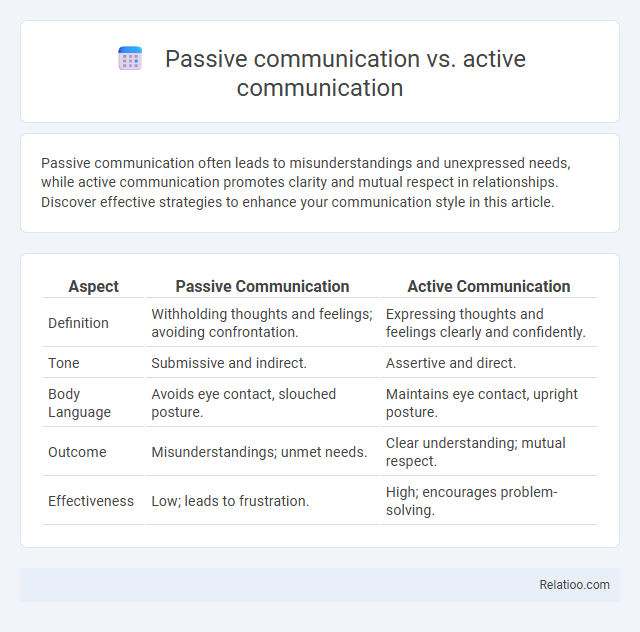Passive communication often leads to misunderstandings and unexpressed needs, while active communication promotes clarity and mutual respect in relationships. Discover effective strategies to enhance your communication style in this article.
Table of Comparison
| Aspect | Passive Communication | Active Communication |
|---|---|---|
| Definition | Withholding thoughts and feelings; avoiding confrontation. | Expressing thoughts and feelings clearly and confidently. |
| Tone | Submissive and indirect. | Assertive and direct. |
| Body Language | Avoids eye contact, slouched posture. | Maintains eye contact, upright posture. |
| Outcome | Misunderstandings; unmet needs. | Clear understanding; mutual respect. |
| Effectiveness | Low; leads to frustration. | High; encourages problem-solving. |
Understanding Passive Communication
Passive communication often involves avoiding expressing thoughts or feelings, leading to misunderstandings and unmet needs. Understanding passive communication helps you recognize patterns of silence or compliance that can hinder effective interaction and personal boundaries. Developing awareness of these behaviors enables a shift towards more assertive and active communication styles, promoting clearer and healthier exchanges.
Defining Active Communication
Active communication involves engaging in clear, direct exchanges where your message is expressed confidently and feedback is encouraged to ensure mutual understanding. Passive communication tends to avoid confrontation, leading to unclear or withheld messages, while aggressive communication often disregards others' feelings, causing conflict. Understanding these styles helps you choose the most effective way to convey your thoughts and build positive interactions.
Key Differences Between Passive and Active Communication
Passive communication involves avoiding expressing your thoughts or feelings, often leading to misunderstanding and unmet needs, while active communication requires openly sharing your ideas and emotions with clarity and confidence. Active communication promotes effective dialogue and resolves conflicts by encouraging honest feedback, whereas passive communication may create frustration and resentment due to lack of assertiveness. Understanding these key differences can empower your interactions, fostering healthier relationships and improved mutual understanding.
Characteristics of Passive Communicators
Passive communicators often avoid expressing their thoughts and feelings directly, prioritizing others' needs over their own and frequently leading to misunderstandings or unmet needs. Their communication style is characterized by a lack of eye contact, soft or hesitant speech, and a tendency to apologize excessively, which can result in diminished self-esteem and internalized stress. Understanding these traits can help you recognize passive communication patterns and encourage more assertive, active interactions for healthier relationships.
Traits of Active Communicators
Active communicators exhibit traits such as assertiveness, clarity, and confidence, enabling them to express their thoughts and feelings directly and effectively. They prioritize listening attentively and provide constructive feedback, fostering mutual understanding and collaboration. Unlike passive communicators who avoid confrontation, active communicators maintain open dialogue and take responsibility for clear message delivery.
Common Examples of Passive Communication
Common examples of passive communication include avoiding eye contact, speaking softly or hesitantly, and failing to express opinions or needs clearly. Individuals using passive communication often prioritize others' preferences over their own, leading to misunderstandings and unaddressed conflicts. This style contrasts with active communication, which involves assertive expression and engagement, and aggressive communication, characterized by forceful or hostile interactions.
Real-World Scenarios Involving Active Communication
Active communication thrives in real-world scenarios such as team meetings, client negotiations, and conflict resolution, where clear, direct, and responsive interaction enhances understanding and decision-making. Passive communication often leads to misunderstandings and unresolved issues due to lack of clarity or engagement. Unlike passive communication, active communication fosters collaboration and efficiency by encouraging feedback, open dialogue, and mutual respect.
Advantages and Disadvantages of Passive Communication
Passive communication often leads to misunderstandings and unmet needs as it avoids expressing thoughts or feelings directly, causing frustration and resentment. You may benefit from its advantage of maintaining harmony and avoiding conflict temporarily, but prolonged passive communication can hinder personal growth and relationships. Recognizing its drawbacks, such as lack of assertiveness and potential for being overlooked, helps in developing more effective communication skills.
Benefits of Adopting Active Communication Skills
Active communication enhances clarity and reduces misunderstandings by promoting open dialogue and attentive listening. It fosters stronger relationships and collaboration within teams, leading to increased productivity and problem-solving efficiency. Adopting active communication skills also helps individuals express ideas confidently, creating a more engaging and positive environment.
How to Transition from Passive to Active Communication
Transitioning from passive to active communication involves recognizing patterns of avoidance and self-suppression and consciously practicing assertiveness and clear expression of needs. Utilizing techniques such as "I" statements, maintaining eye contact, and setting boundaries empowers individuals to convey their thoughts and feelings more effectively. Consistent self-reflection and seeking feedback promote the development of active communication skills, leading to improved interpersonal relationships and conflict resolution.

Infographic: Passive communication vs Active communication
 relatioo.com
relatioo.com